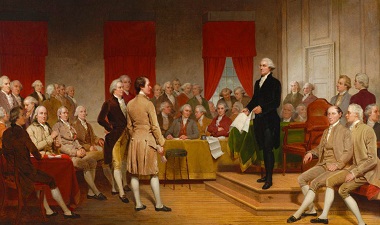In a three-part series, Constitution Daily looks at a series of landmark cases that have defined First Amendment rights and free speech for the press. In part two, we review how controversies from the World War I era and its aftermath shaped laws that eventually expanded free speech.
After the Civil War and before World War I, printed news media including newspapers experienced growth without open government censorship of the press as a significant factor. However, the United States’ involvement in a global conflict brought back a familiar act from the founding era.
The United States formally entered World War I on April 6, 1917, when Congress approved a war declaration proposed by President Woodrow Wilson. The question soon arose about an Espionage Act also proposed by Wilson to Congress. Wilson had insisted on a provision to allow for censorship of anyone who printed information “of such character that it is or might be useful to the enemy.” The House rejected the censorship provision, and the administration settled for a revised Espionage Act on June 15, 1917. The Espionage Act made it a crime to convey information that could “be used to the injury of the United States, or to the advantage of any foreign nation.”
Part One of Series: A look at early landmark free press censorship cases
The Espionage Act also allowed the Postmaster General to block the delivery of printed materials interpreted to interfere with the war effort. The act was tested when the New York City postmaster denied delivery of a magazine accused of asking readers to avoid the draft. In Masses Publishing Co. v. Patten (1917), a young federal district judge, Learned Hand, ruled that the magazine had not violated the Espionage Act by publishing false information and advocating “resistance to the recruiting and enlistment service.” An appeals court overturned Hand’s ruling, but his concept that speech that didn’t directly incite violence was protected speech was influential in later decisions.
The Sedition Act Returns
Congress amended the Espionage Act in May 1918 to include more provisions, also known as the Sedition Act of 1918, that restricted free speech and the free press. The amendments made it illegal to “willfully utter, print, write, or publish any disloyal, profane, scurrilous, or abusive language about the form of government of the United States, or the Constitution of the United States, or the military or naval forces of the United States.”
The act and its amendments faced several Supreme Court tests. In Schenck v. United States (1919), a unanimous Court upheld Socialist leader Charles Schenck’s conviction under the Espionage Act of mailing printed circulars critical of the draft. Justice Oliver Wendell Holmes said in ordinary times Schenck’s actions may have represented protected free speech, but Schenck’s “words used are used in such circumstances and are of such a nature as to create a clear and present danger that they will bring about the substantive evils that Congress has a right to prevent.” Holmes pointed out to the example of “a man in falsely shouting fire in a theater and causing a panic” as unprotected speech.
Brandeis on Free Speech
A similar case came to the Court later that year. In Abrams v. United States (1919), Russian immigrants were accused of violating the Sedition Act of 1918 by handing out pamphlets that criticized the use of American forces in Eastern Europe after the Russian Revolution. In his 7-2 majority decision, Justice John H. Clarke rejected an argument that the Sedition Act violated the First Amendment, pointing to Justice Holmes’ Schenck opinion.
However, Justice Holmes, joined by Justice Louis Brandeis, dissented in Abrams. “I do not see how anyone can find the intent required by the statute in any of the defendants’ words,” Holmes wrote. “I believe the defendants had as much right to publish as the Government has to publish the Constitution of the United States now vainly invoked by them.”
“But when men have realized that time has upset many fighting faiths, they may come to believe even more than they believe the very foundations of their own conduct that the ultimate good desired is better reached by free trade in ideas -- that the best test of truth is the power of the thought to get itself accepted in the competition of the market, and that truth is the only ground upon which their wishes safely can be carried out. That, at any rate, is the theory of our Constitution. It is an experiment, as all life is an experiment,” he concluded.
By March 1921, Congress repealed the Sedition Act amendments to the Espionage Act. And three other cases, and their dissents, over the next 10 years further shaped free press rights. In Gitlow v. New York (1925), a divided Court upheld Benjamin Gitlow’s conviction under a New York state law for distributing printed circulars that promoted socialism. The Court majority said Gitlow’s manifesto advocated for overthrowing the government. In a dissent, Justice Holmes joined by Justice Brandeis, disagreed with that conclusion. “The only difference between the expression of an opinion and an incitement in the narrower sense is the speaker’s enthusiasm for the result,” Holmes wrote. Of perhaps greater importance, the majority’s Gitlow decision established the precedent that the First Amendment protected against abuses by state and local governments under the 14th Amendment. Under the original Bill of Rights, the First Amendment only applied to abuses by the national government—not state and local governments.
The Court’s decision in Whitney v. California (1927) was not directly about printed speech. It dealt with a California law that barred Communist Party meetings. Anna Whitney was convicted of attending such a meeting under the California Criminal Syndicalism Act. A unanimous court upheld the state law, but it was a concurrence from Justice Brandeis that proved highly influential in establishing a framework that defined freedom of speech and the press.
“Those who won our independence believed that the final end of the State was to make men free to develop their faculties, and that, in its government, the deliberative forces should prevail over the arbitrary,” Brandeis argued. “They believed that freedom to think as you will and to speak as you think are means indispensable to the discovery and spread of political truth; that, without free speech and assembly, discussion would be futile.”
Brandeis also offered his own view on Holmes’ Schenck test: “No danger flowing from speech can be deemed clear and present unless the incidence of the evil apprehended is so imminent that it may befall before there is opportunity for full discussion. If there be time to expose through discussion the falsehood and fallacies, to avert the evil by the processes of education, the remedy to be applied is more speech, not enforced silence.”
Bans on Prior Restraints
The Supreme Court then upheld the right of the free press to be free of government censorship of its content before publication. In Near v. Minnesota (1931), a newspaper in Minneapolis accused government officials of connections with organized crime. The officials sought a gag order and claimed the under a state nuisance law the comments could be banned before publication as defamatory.
In a 5-4 decision, Chief Justice Charles Evans Hughes ruled the state law could not be used to place previous restraints, or prior censorship, on published materials. The majority also said the Bill of Rights’ protections to the states under the 14th Amendment as stated in Gitlow applied in the Near case. “The liberty of the press has been especially cherished in this country as respects publications censuring public officials and charging official misconduct,” Hughes wrote. “Public officers find their remedies for false accusations in actions for redress and punishment under the libel laws, and not in proceedings to restrain the publication of newspapers and periodicals,” Hughes wrote.
In his dissent, Justice Pierce Butler noted that “the decision of the Court in this case declares Minnesota and every other State powerless to restrain by injunction the business of publishing and circulating among the people malicious, scandalous and defamatory periodicals ...adjudged to be a public nuisance.” Pierce did not believe the First Amendment fell under the due process provisions of the 14th Amendment, but acknowledged the decision’s importance. “This Court was not called on until 1925 to decide whether the ‘liberty’ protected by the Fourteenth Amendment includes the right of free speech and press. That question has been finally answered,” he concluded.
Scott Bomboy is the editor in chief of the National Constitution Center.







